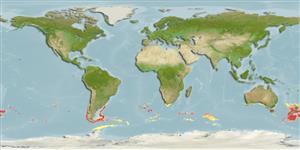Environment: milieu / climate zone / depth range / distribution range
Ecologia
marinhas batidemersal; não migratória; intervalo de profundidade 200 - 1200 m, usually 500 - 800 m (Ref. 1371). Deep-water; 34°S - 65°S, 180°W - 180°E (Ref. 1371)
Southern Atlantic, Indian and Pacific: Subantarctic to temperate waters on both sides of South America, Falkland Islands, Discovery Tablemount and Meteor Seamount, South Africa, off Crozet and Prince Edward Islands, and off New Zealand and Macquarie Island.
Length at first maturity / Tamanho / Peso / Idade
Maturity: Lm 57.5, range 55 - 60 cm
Max length : 100.0 cm TL macho/indeterminado; (Ref. 1371); Idade máx. registada: 19 anos (Ref. 7059)
Espinhos dorsais (total) : 2; Espinhos anais: 0. Head short, its underside moderately to extensively scaled, but sometimes only a file or narrow band of small scales is present below the suborbital and preopercular ridges and posteriorly on lower jaw. Eyes relatively large. Snout short, moderately pointed, with small naked patches on dorsal surface behind leading edges. Pyloric caeca 13 to 21. Overall color is medium brown to somewhat straw color; fins darker, blackish in some; the dorsal and pelvic fins darker distally; oral cavity lining dark gray or brown.
A benthic species found on the continental slope (Ref. 75154). This species is being imported and sold to the United States by the Argentines under the name grenadero (Ref. 5171).
Life cycle and mating behavior
Maturities | Reprodução | Spawnings | Egg(s) | Fecundities | Larvas
Cohen, D.M., T. Inada, T. Iwamoto and N. Scialabba, 1990. FAO species catalogue. Vol. 10. Gadiform fishes of the world (Order Gadiformes). An annotated and illustrated catalogue of cods, hakes, grenadiers and other gadiform fishes known to date. FAO Fish. Synop. 125(10). Rome: FAO. 442 p. (Ref. 1371)
Categoria na Lista Vermelha da IUCN (Ref. 130435)
Ameaça para o homem
Harmless
Utilização humana
Pescarias: espécies comerciais
Ferramentas
Relatórios especiais
Descarregue XML
Fontes da internet
Estimates based on models
Preferred temperature (Ref.
123201): 3.2 - 8.1, mean 6.7 °C (based on 164 cells).
Phylogenetic diversity index (Ref.
82804): PD
50 = 0.5312 [Uniqueness, from 0.5 = low to 2.0 = high].
Bayesian length-weight: a=0.00282 (0.00170 - 0.00467), b=3.18 (3.03 - 3.33), in cm total length, based on LWR estimates for this species & (Sub)family-body (Ref.
93245).
Nível Trófico (Ref.
69278): 3.7 ±0.58 se; based on food items.
Resiliência (Ref.
120179): Baixo, tempo mínimo de duplicação da população 4,5 - 14 anos (tmax=19).
Fishing Vulnerability (Ref.
59153): High vulnerability (60 of 100).
Nutrients (Ref.
124155): Calcium = 19.5 [11.2, 47.6] mg/100g; Iron = 0.456 [0.212, 0.944] mg/100g; Protein = 16.9 [14.7, 19.1] %; Omega3 = 0.219 [0.102, 0.454] g/100g; Selenium = 28.6 [11.1, 65.6] μg/100g; VitaminA = 7.71 [1.54, 36.85] μg/100g; Zinc = 0.293 [0.188, 0.453] mg/100g (wet weight);
